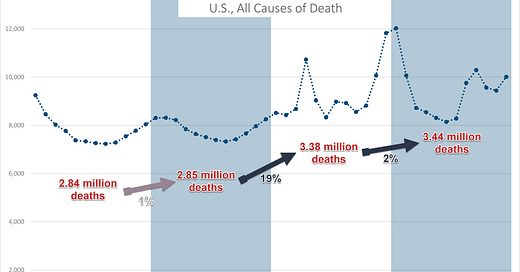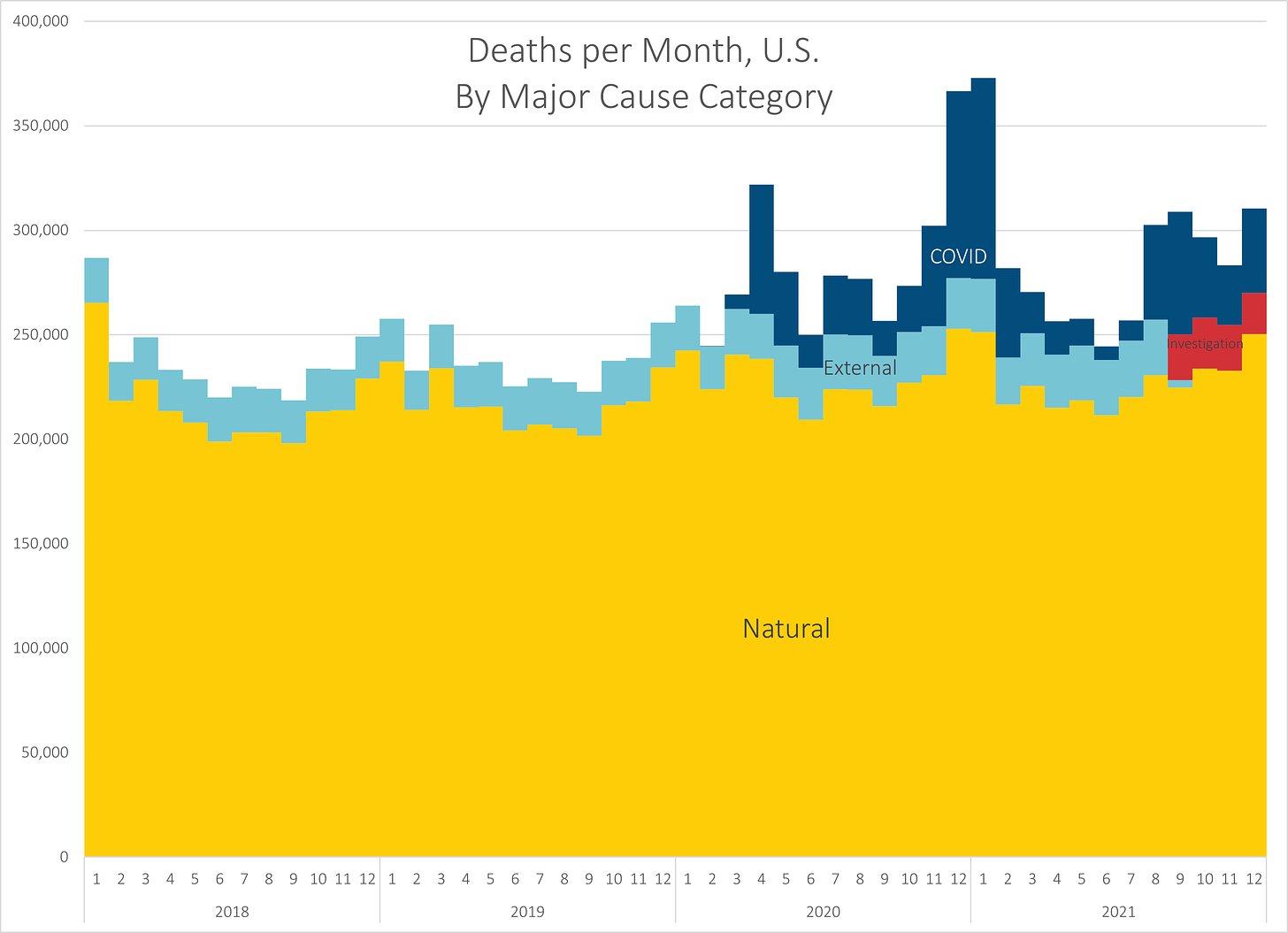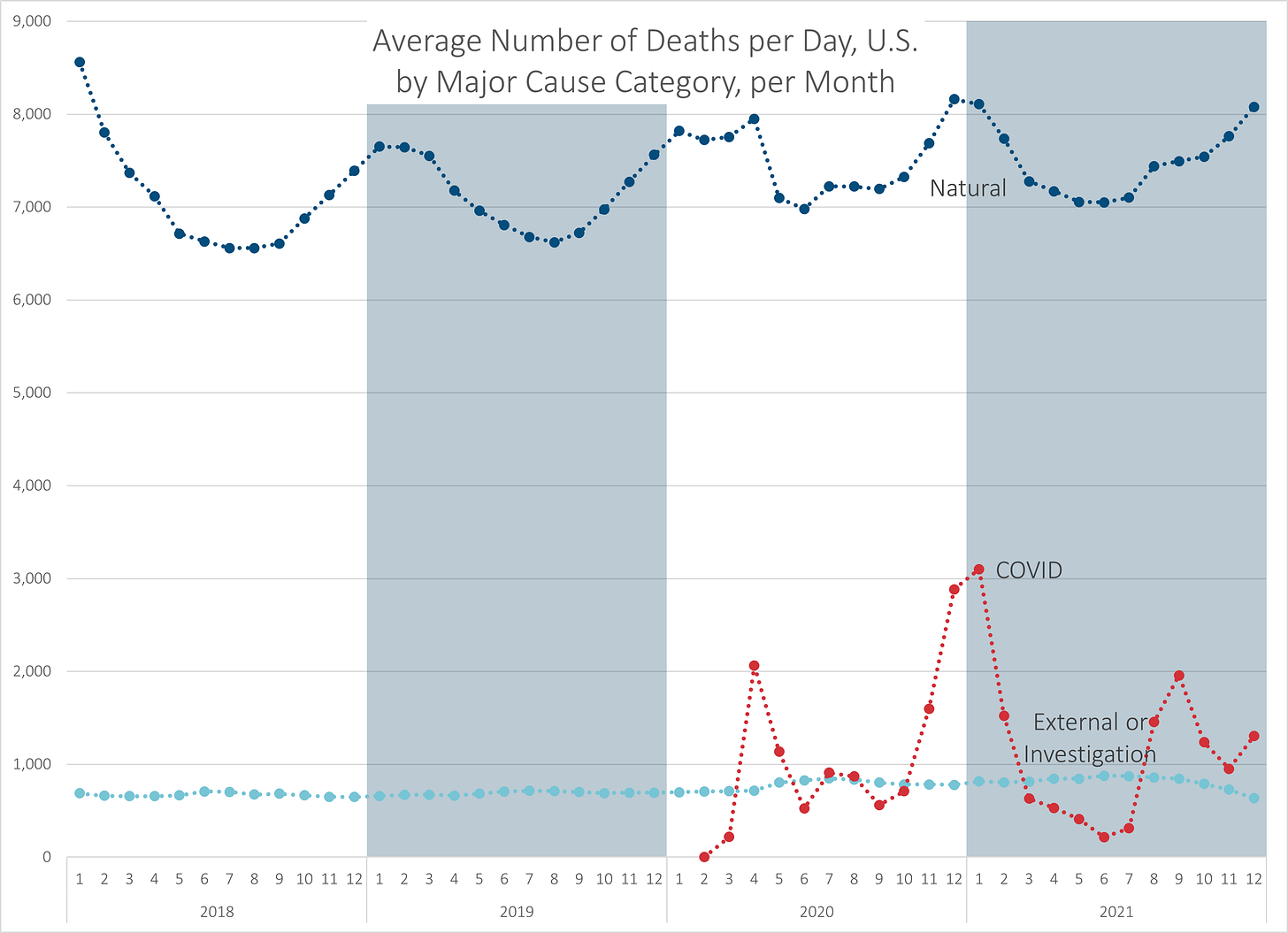Preliminary results for 2021 All-Cause U.S. Mortality: 21% More Deaths than 2019, 2% More Deaths than 2020
Age 40-44 had 50% more deaths in 2021 than in 2019 in U.S., from all causes
Rather than wait for the next refresh of the provisional mortality database at CDC WONDER (which should happen in about a week), here is a high-level set of results for all-cause mortality in the U.S. in 2021.
Just to the bottom of the post for the spreadsheet and methodology, if you are so inclined. If you are not so inclined, let us jump in to the top results.
Top results
Mortality results were worse in 2021 compared to 2020 — 2% more deaths in 2021 than 2020, and 21% more in 2021 than 2019.
Deaths haven’t been fully reported for 2021 yet, so that number will only increase. At the very least, there are indications that external causes of death (drug overdoses, homicides, suicides, motor vehicle accidents, etc.) are under-reported for the end of 2021.
Age 40-44 age group had 50% more deaths in 2021 than in 2019, the worst relative mortality of all age groups. Ages 30-39 also saw high relative mortality with over 40% increase in deaths in 2021 compared to 2019.
More detail below.
Trend over time
Here are the deaths shown as average of deaths per day, graphed by month, for 2018 through the end of 2021:
As you can see from the annotation on the graph, so far there have been 2% more deaths reported in 2021 compared to 2020. You can see that there had been a spike of deaths at the beginning of 2021, then a quiet spring/early summer. I did not extend my graph into 2022, but the heightened mortality of later/summer fall into winter has continued into winter at the beginning of 2022.
For the record, the 1% increase in deaths from 2018 to 2019 was pretty common before, driven by regular growth of the aging population of the U.S.
Here’s a second graph, showing both 2020 and 2021 with their daily average deaths compared against the same month in 2019, as percentage increases:
Even those “quiet” spring 2021 months were elevated in terms of mortality. For the whole year, 2021 had 21% more deaths than 2019.
Just a remark re: comparing against 2019 — 2019 was a very sedate year for mortality. I’m not even bothering comparing against an average. I am including 2018 in that first graph, because you can see the tail end of a “bad” flu season there. But the 2018-2019 flue season was tame.
Major categories of death trends
I am breaking out the following causes of death: COVID (of course), other natural causes of death, external Causes of Death (accidents, suicide, homicide, etc.), and “still under investigation/censored”.
Let me explain that last category, which I’ve mentioned this when I was doing some of my posts on drug overdoses and homicides. Many of the “nasty” causes of death don’t get reported right away in the databases, partly due to their sensitive natures, but often because they do take longer to investigate as intent is an important component of these causes of death.
Almost all of these, though, will be “external causes”.
Let me just show the graph without doing anything special with it:
So we see the raw numbers going up and down. It’s very difficult to make comparisons here, or tell what, if anything, is going on with any of the components, other than COVID. We can see the COVID spikes, but that’s it.
Let me now combine the External with the “still under investigation” categories, because these are essentially the same. And switch over to a line graph.
We do see some weird things going on with the Natural causes (other than COVID), and we do see the COVID pattern, but it’s tough to see what’s going on with the External/investigation category. So let’s remove the other lines:
Yes, there’s a 12% increase from April 2020 to May 2020, but I didn’t highlight that bit. I circled the end of 2021, because even with adding the cases under investigation or censored, there’s still too few deaths — I really don’t believe accidents and drug overdoses fell off that rapidly. I think there’s just a longer reporting process for those.
I know for sure that COVID deaths get into the database faster than many other causes of death. That causes a distortion in trying to analyze causes of death if you don’t take that into account.
Focus on age groups
The last bit I want to show are the changes for age groups, and for this post, I’m using the 5-year age groups instead of the 10-year age groups I used to use.
Here are the results for 2020 and 2021, done two ways.
First, just simple subtraction — just number of deaths for 2020 or 2021 minus the number of deaths for 2019 for that same reference group:
In looking at the difference in deaths, we can see that the “excess deaths” obviously went up, but it also shifted to younger ages. But by shifting to “younger ages”, I mean the peak of the excess deaths shifted from 75-79 years old group to 70-74 years old group. That’s just if we’re looking at absolute numbers of deaths.
Part of this, of course, is if you kill off a bunch of 85+ year-olds, particularly the most vulnerable ones, in 2020, they’re not around to die in 2021.
Millennial massacre – 2021 was brutal
But let’s look at the ugliest graph of them all: the relative change in the number of deaths. What is the percentage increase in the number of deaths compared to 2019, by age group?
That is ugly with a capital UGH.
An over 50% increase in the number of deaths of those aged 40-44 from 2019 to 2021.
Just so you have concrete numbers: it went from 44K deaths of those 40-44 in 2019, to 68K of those aged 40-44 in 2021.
This particular mortality impact is why I kept putting off doing this post – and obviously, it was not just age 40-44 that had ugly results. IAge 30-39 is fairly horrific, too, in what happened in 2021. I’m just older than these groups — about to turn 48 this month, so I’ve had my eye on these trends.
I’ve been working up to this with my series on the ugly causes of death: motor vehicle accidents, drug overdoses, homicides, alcohol-related deaths, etc. I will again copy a link to these below.
The good news in the above graph is the child impacts have been low.
Next steps
I will be doing further posts, as I want to do deeper dives into aspects of these results. I will do posts on different age groups (for example, just looking at pediatric mortality, if we want to look for some good-ish news), digging further into specific causes of death, and more.
As well, the monthly update of the database will be coming soon for April, and I’ll update my spreadsheets accordingly. The numbers can only go up, in terms of numbers of deaths for 2021, though causes of death may shift. As I noted, I think the “external” counts are low for the end of 2021. I’m sure those will be going up substantially.
I will be looking at age-adjusted death rates and crude death rates in future posts as well, not just death counts.
There are loads of analyses to be had. Some will have to wait for more complete data, but given the data we already have, it still looks pretty brutal.
Here are the links to prior posts on the nasty causes of death:
Suicide
Suicide: Trends, 1968-2020, and Provisional Counts Through June 2021 – this one had only one standalone post, but I’m not done with this topic yet.
Mortality Nuggets: Videos on Suicide Rate Trends, Society of Actuaries Report, and Fixing Their Graph — there are a variety of mortality trends covered in video form here, and suicide rate trends are in the first video.
Homicide
Homicide: Trends, 1968-2020, and Provisional Counts Through June 2021
The Geography of Homicide — States, Base Rates, Increases, and Correlations
Motor vehicle accidents
Motor Vehicle Accident Deaths: High-Level Trends, 1968-2020, Part 1
Motor Vehicle Accident Deaths, Part 2: Age-Related Trends with Provisional Results in 2021
Motor Vehicle Accident Deaths, Part 3: Geographical Differences, 2019 vs 2020
Drug overdose deaths
Drug Overdoses, Part 1: High-Level Trends, 1999-2020
Drug Overdose Deaths, Part 2: U.S. Age-Related Trends 1999-2020 with Provisional Results in 2021
Drug Overdose Deaths, Part 3: Geographical Differences for 2019 and 2020
Alcohol-related deaths
Part 1: Dead is dead: Increased Alcohol-Related Deaths, U.S., 2020-2021
Part 2: Alcohol-related deaths, part 2: Geographical Differences for 2019 and 2020
As a reminder, I have a Mortality with Meep category, if you want to only look at mortality-related posts (I do write about other things, like public finance).
Methodology
The provisional death counts come from the CDC WONDER provisional mortality database, using multiple queries on the vintage of data for deaths as of March 6, 2022 (that is, the last time they uploaded data into that database was March 6, 2022. They refresh this database monthly in their current process.)
Dates of data draws ranges from March 29, 2022 to April 2, 2022. However, they’re all from the same vintage database.
A variety of aggregations were made on the database – by year, by year and month, by ICD Chapter for Underlying Cause of Death, by 10-year age groups, etc. Due to suppression rules in the database, totals across categories were compared to ensure that totals footed — sometimes they did not add up to the same numbers, but when they did not, differences tended to be immaterial (<< 0.1% in tolerance).
Data in CDC WONDER are based on actual death certificates submitted by various departments of health funnelled through the states. This has effects, because, in particular, North Carolina has an antiquated process meaning their reporting are months behind current dates. Most other states have reporting lags that are only a few weeks behind current dates, and most of 2021 data are complete or 99% complete for those states. Shame, North Carolina. Do better. I did not attempt to project deaths for this under-reporting.
Death rates are based on population size estimates provided by CDC WONDER, and age-adjusted rates are based on a 2000-standardized reference population. All further documentation can be found within the spreadsheet linked below.










